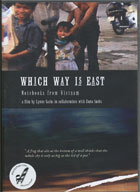
Which Way is East: Notebooks from Vietnam 1994 (reissued 2005)
Distributed by Microcinema International/Microcinema DVD, 1636 Bush St., Suite #2, SF, CA 94109; 415-447-9750
Produced by Lynne Sachs
Directed by Lynne Sachs in collaboration with Dana Sachs
DVD, color, 33 min., in English and Vietnamese
Sr. High - Adult
Asian Studies, History, Multicultural Studies, Travel and Tourism
Date Entered: 09/11/2006
Reviewed by Maureen Puffer-Rothenberg, Valdosta State University, Valdosta, GAThis is the 2005 re-release of Lynne Sachs’ experimental documentary, originally issued in 1994. Sachs filmed during a visit with her sister Dana who was then teaching in Vietnam, then blended her footage with comments on their experiences, anecdotes about people they met, and Vietnamese proverbs.
The sisters meet a former Vietcong soldier and visit a shrine, where they learn that religious practices once banned by the government are now allowed. They interview a woman who lived in an underground tunnel complex during the war and visit fields that remain bombed-out years later. Dana discusses the custom of eating large quantities of whatever fruit is in season. Lynne becomes ill in a hotel and Dana befriends the kitchen help; Dana says she hates the camera because it sees only a small part of the world. Lynne feels hampered in her effort to learn about Vietnam in a limited timeframe, and notes her own tendency to see drama in the merely unfamiliar.
The voiceover narrative is engaging but rarely connected to images on the screen. Regardless of topic, the Sachs’ comments are illustrated by Vietnamese riding bicycles past the camera, fishing, sifting grain, standing in the street or performing chores in apparent poverty. In several sequences Vietnamese children (perhaps Dana Sachs’ students) simply look into the camera. Occasionally the screen goes black and a proverb appears in Vietnamese while the voiceover provides an English translation. Rather than a documenting interviews or experiences in Vietnam, the film combines footage shot in Vietnam with narration supplied later—sometimes by Vietnamese speakers--in the United States. Apparently Sachs ultimately chose to include stories for which she had little or no actual footage.
Lengthy impressionistic sequences blend sound and color as blurred images speed past the camera, offering only glimpses of buildings or trees, a technique perhaps intended to communicate the overwhelming sensory experience of traveling through a foreign environment. A plethora of film-school tricks including color washes, double exposures, mirroring, slow motion and stop-motion distract from the narrative.
Often difficult to watch and offering primarily anecdotal information, Which Way is East holds questionable educational value but might be used to supplement more in-depth studies of Vietnamese culture. Sachs does raise issues of how Americans experience foreign cultures.
Awards
- Grand Jury Prize, Atlanta Film Festival
- Best Documentary, New York Film Expo
- Citation, “Black Maria Film Fest”